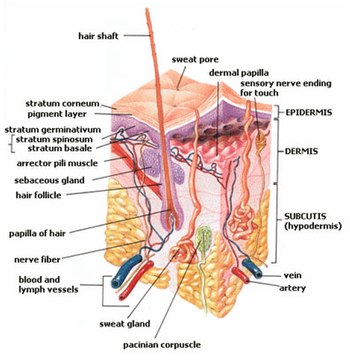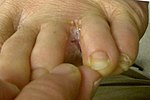Sweaty foot
| Classification according to ICD-10 | |
|---|---|
| R61.0 | circumscribed hyperhidrosis |
| ICD-10 online (WHO version 2019) | |
The excessive perspiration in the area of the feet is referred to as the sweat foot , in medical terms hyperhidrosis pedis or hyperhidrosis plantaris .
Anatomical and physiological basics
The soles of the feet and palms are covered with a particularly large number of eccrine sweat glands , usually around 500 per cm 2 . These are not used for thermoregulation , but for better adhesion of the (bare) feet to a surface. This can also be seen in the fact that the corresponding sweat production of the hands and feet is not controlled by the thermoregulatory center , but by a separate center of the central nervous system via the sympathetic part of the autonomic nervous system. The sweating of the hands ( sweaty hands ) and feet (palmoplantar) is mediated via sympathetic nerve fibers and does not occur during sleep.
Overactive sweat glands
An overactivity of the autonomic nervous system and an abnormal size of the sweat glands are seen as the causes of increased perspiration, which can be influenced by other factors. The increased sweating all over the skin is known as general hyperhidrosis . A localized hyperfunction (focal form) usually occurs in the area of the armpits (axillae) called hyperhidrosis axillaris or the hands ( sweaty hands , hyperhidrosis palmaris ) and also the feet ( hyperhidrosis plantaris ). The latter is called overactive if the fluid secreted is more than 50 mg per foot per minute.
In terms of feet, there are terms in everyday language such as athletes feet, stinky feet, cheese feet, cheesecake, cheese sequants or cheese feet, whereby these terms are used not only in the case of an overactive sweat secretion on the feet, but mainly to allude to particularly strong foot odor, which is caused by Sweaty feet can however be favored. The term cheese foot is derived from similar bacterial decomposition processes that are also used in the production of cheese. This results in the characteristic, cheesy foot odor.
With sweaty feet, the horny layer of the skin is constantly moisturized due to increased sweating, so that it can soften and swell - a change that is known in English as pitted keratolysis . The intensifying factors include air-impermeable shoes or socks, which can lead to the formation of a so-called humid chamber, i.e. an accumulation of sweat on the foot. In extreme situations this can lead to U. the immersion foot arise, which is a particularly feared soldier's disease in times of war.
diagnosis
Overactive sweat glands on the feet can be measured by applying an iodine tincture and, after drying, powdering it with potato starch . Since the exuding sweat changes the painted and powdered surface significantly by turning it blue, the intensity of this color change also shows the individual characteristics of the sweat flow. This test is also suitable for monitoring the progress of therapy.
Skin status
The constant moisture penetration of the horny layer enables an increase in the local bacterial flora, thus also a decomposition of the keratin and ultimately an intense odor ( bromhidrosis ), which can cause those affected to get into social isolation . In addition to an increased bacterial colonization, it is often also of human papillomavirus caused Plantar warts ( verruca plantar ) and fungal infections , usually a Interdigitalmykose (fungal infection between the toes), both of which are often difficult to treat.
Medical studies
A study by Berthold Rzany and his colleagues at the Charité Dermatology Clinic in Berlin with 30 patients with tinea pedis and 51 control participants showed that the rate of athlete's foot infections in sweaty foot patients is approximately 3.5 times higher than in normal patients.
The Dutch researcher Bart Knols from Wageningen University suspects that a certain type of fat-breaking bacteria called Brevibacterium epidermidis is the type of bacteria that is responsible for the strongest odor development. Fatty acids broken down by bacteria would result in the characteristic odor. The Limburger cheese matures with the help of the closely related bacterium Brevibacterium linens .
Natural or cultural cause of foot odor
The above-mentioned study results must be put into perspective with regard to odor formation, because it remains to be clarified whether sweaty feet in their natural state (i.e. constantly barefoot ) also develop a strong odor, or whether foot odor is mainly caused by wearing socks and shoes.
Bare feet - even in sandals - are better ventilated and can dry in the air and above the ground, whereas in socks and closed shoes there is a warm and humid microclimate that promotes bacterial sweat decomposition and thus the development of foot odor. At best, the sweat will be absorbed by the socks (or shoes); however, these can also develop an intense odor. Foot odor that does not occur due to sweaty feet, foot or nail fungus infestation is not harmful, so in such cases no countermeasures are necessary in addition to general foot hygiene .
Helpful measures
Sweaty feet are not a sign of poor foot care or hygiene in general . Foot care can reduce the build-up of odors, but does not counteract excessive sweat production.
The following measures are recommended:
- Wearing toe socks that absorb sweat better due to the larger contact area with the skin
- Foot baths in cold salt water
- Creaming with skin cream
- frequent cleaning of the feet (especially with cold water)
- Foot baths with tannic acid
- to run barefoot
- odor-inhibiting insoles that contain , for example, activated carbon , cedarwood and / or cinnamon
- Wear breathable shoes
- frequent changing of socks
- Socks with copper or silver ions
- mechanical removal of excess skin layers
- Antibacterial substances are sometimes recommended. Portuguese researchers were able to show that even in low concentrations lavender oil kills various yeasts ( Candida species ) and filamentous fungi , which can cause foot and nail fungal diseases in humans.
To combat hyperhidrosis, a number of alternative and complementary medical treatment methods are offered, which can be successful in individual cases , but have a very different response from individual to individual. Such measures include daily intake of diluted apple cider vinegar or foot baths with apple cider vinegar, radiotherapy , massage , hypnotherapy , herbal baths, and acupuncture . However, such measures against hyperhidrosis are poorly documented and only show success in individual cases.
Medical therapy
Professional medical therapy is usually carried out in the following order if necessary:
- Aluminum chloride therapy (see hyperhidrosis )
- Tap water iontophoresis
- Injection of botulinum toxin (botox) into the skin of the foot surface (intradermal) under light anesthesia at intervals of about six months
- CT- assisted lumbar sympathicolysis
- Here, phenol is injected into the ganglion of the sympathetic trunk at the Th12 on both sides under local anesthesia . The sweating on the feet then remains - with successful therapy - on average for a full year.
- In particularly severe cases, surgical severing of the relevant nerve can be used as a last resort . However, this procedure is rarely performed due to the risk of sexual dysfunction and erectile dysfunction .
literature
- Peter Fritsch: Dermatology, Venereology. Basics, clinic, atlas. (= Springer textbook. ). 2nd edition, Springer, Berlin a. a. 2004, ISBN 3-540-00332-0 .
- Monika Sonntag, Thomas Ruzicka: Hyperhidrosis - cause and current treatment options. In: Psychoneuro 2005. Volume 31, No. 6, pp. 315-320, doi : 10.1055 / s-2005-871978 .
Individual evidence
- ↑ a b E. Brettschneider: Botulinum toxin against sweaty feet . rbb : QUIVIVE broadcast on May 30, 2007, accessed on June 16, 2007.
- ↑ a b WDR : Quarks & Co: Sweating; 6. sweaty feet. ( Full text as Pdf file ( Memento from November 11, 2013 in the Internet Archive )).
- ↑ M. Zuzarte, MJ Goncalves et al. a .: Chemical composition and antifungal activity of the essential oils of Lavandula viridis L'Her .. In: Journal of Medical Microbiology. Volume 60, 2011, pp. 612-618, doi : 10.1099 / jmm.0.027748-0 .
- ^ A. Angioni, A. Barra, V. Coroneo, S. Dessi, P. Cabras: Chemical composition, seasonal variability, and antifungal activity of Lavandula stoechas L. ssp. stoechas essential oils from stem / leaves and flowers. In: Journal of agricultural and food chemistry. Volume 54, Number 12, June 2006, pp. 4364-4370, doi : 10.1021 / jf0603329 , PMID 16756368 .
- ↑ M. Zuzarte, MJ Gonçalves, C. Cavaleiro, AM Dinis, JM Canhoto, LR Salgueiro: Chemical composition and antifungal activity of the essential oils of Lavandula pedunculata (Miller) Cav. In: Chemistry & biodiversity. Volume 6, Number 8, August 2009, pp. 1283-1292, doi : 10.1002 / cbdv.200800170 , PMID 19697345 .
- ↑ a b Debby Mayne: Apple Cider Vinegar Cure for Hyperhidrosis . From: ehow.com , accessed September 29, 2014.
- ^ A b David H. Nielson: Alternative to Surgery for Excessive Sweating Treatment . From: hyperhidrosis-usa.com , accessed September 29, 2014.
- ↑ E. Holze: Therapy of hyperhidrosis. In: dermatologist. Jan. 1984; Volume 35, No. 1, pp. 7-15, PMID 6706577 .

